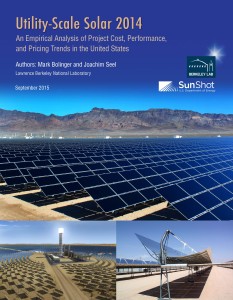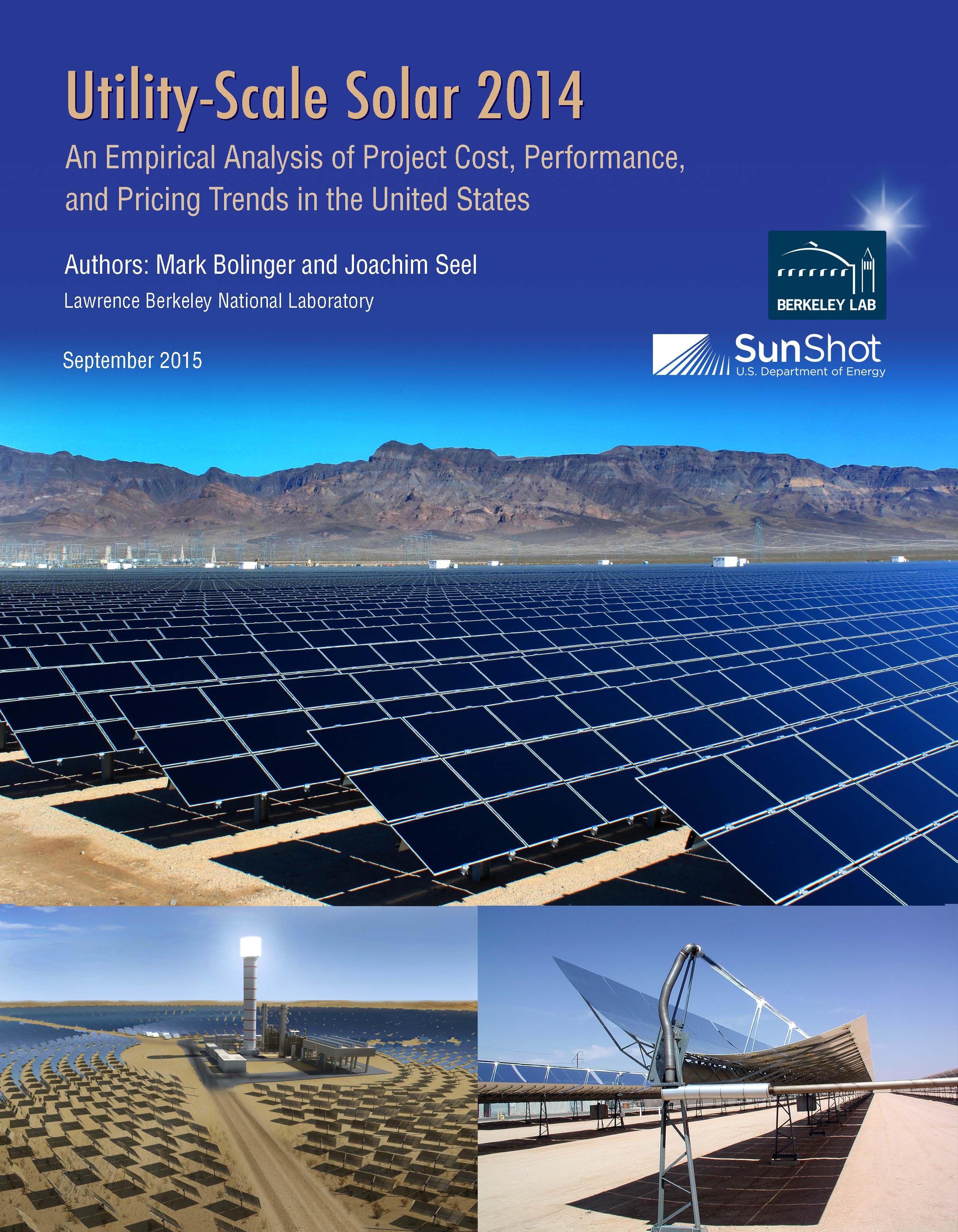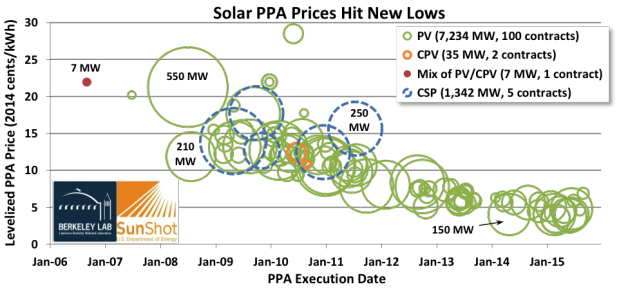Solar energy pricing is at an all-time low, according to a new report released by Lawrence Berkeley National Laboratory (Berkeley Lab). Driven by lower installed costs, improved project performance, and a race to build projects ahead of a reduction in a key federal incentive, utility-scale solar project developers have been negotiating power sales agreements with utilities at prices averaging just 5¢/kWh. These prices reflect receipt of the 30% federal investment tax credit, which is scheduled to decline to 10% after 2016, and would be higher if not for that incentive. By comparison, average wholesale electricity prices across the United States ranged from 3 to 6 cents/kWh in 2014, depending on the region.
 Key findings from Berkeley Lab’s latest “Utility-Scale Solar” report – which each year draws upon large volumes of empirical data to identify key trends in project costs, performance, and pricing among ground-mounted solar projects larger than 5 megawatts (MW) – include the following:
Key findings from Berkeley Lab’s latest “Utility-Scale Solar” report – which each year draws upon large volumes of empirical data to identify key trends in project costs, performance, and pricing among ground-mounted solar projects larger than 5 megawatts (MW) – include the following:
* Installed project costs have fallen by more than 50% since 2009. Median up-front project costs have dropped from around $6.3/W in 2009 to $3.1/W for projects completed in 2014. Some projects built in 2014 were priced as low as $2/W, and the 20th percentile of the sample declined sharply from $3.2/W in 2013 to $2.3/W in 2014. (All numbers are reported in AC watts and 2014 dollars.)
* Newer solar projects generate electricity more efficiently. Projects completed in 2013 performed at an average capacity factor of 29.4% (in AC terms) in 2014 – a notable improvement over the 26.3% and 24.5% average 2014 capacity factors realized by projects built in 2012 and 2011, respectively. This improvement among more-recent project vintages is due to a combination of several trends: newer projects have been sited in better solar resource areas on average, and have increasingly oversized the solar collector field and/or employed tracking technology to increase energy capture.
* Solar power purchase agreement prices have fallen to new lows, making solar an increasingly cost-competitive option for utilities. The improvements in up-front installed costs and capacity factors mentioned above have helped to drive power purchase agreement (PPA) prices to new lows, with PPAs now regularly being signed at prices of 5 cents/kWh or less. Particularly in the Southwest where the solar resource is strongest, there appears to be a deep market at these low prices, as evidenced by several recent utility solicitations for solar energy that have been heavily oversubscribed, with many of the unsuccessful projects offering prices similar to the winning projects. Declining PPA prices have also made utility-scale solar increasingly competitive outside of the traditional stronghold of the Southwest, with recent contract announcements in states like Arkansas (at ~5 cents/kWh) and Alabama (at ~6 cents/kWh) that have not previously seen much solar development.
* A strong pipeline of projects under development reflects utility-scale solar’s increasing competitiveness. There were nearly 45,000 MW of solar capacity making their way through various interconnection queues across the country at the end of 2014 – more than five times the installed capacity base at the time. In another sign of a broadening market, much of the new solar capacity that entered these queues in 2014 is located in regions outside of California and the Southwest, such as Texas and the Southeast. Though not all of the capacity in these queues will ultimately be built, presumably most of those projects that are able to proceed will try to reach commercial operation prior to 2017, when the 30% federal investment tax credit is scheduled to decline to 10%. This looming deadline suggests a frenzied pace of construction over the next 15 months – as well as a wealth of new data to analyze in future editions of this report.
This work was funded by the U.S. Department of Energy’s SunShot Initiative within the Office of Energy Efficiency and Renewable Energy.
# # #
Lawrence Berkeley National Laboratory addresses the world’s most urgent scientific challenges by advancing sustainable energy, protecting human health, creating new materials, and revealing the origin and fate of the universe. Founded in 1931, Berkeley Lab’s scientific expertise has been recognized with 13 Nobel prizes. The University of California manages Berkeley Lab for the U.S. Department of Energy’s Office of Science. For more, visit www.lbl.gov.
DOE’s Office of Science is the single largest supporter of basic research in the physical sciences in the United States, and is working to address some of the most pressing challenges of our time. For more information, please visit science.energy.gov.
Additional Information: The full report (“Utility-Scale Solar 2014”), a PowerPoint briefing that summarizes the report, and an Excel workbook that contains much of the data presented in the report, can all be downloaded from: utilityscalesolar.lbl.gov/ In addition, a webinar covering key findings will be held at 2 PM eastern on Wednesday, September 30. To register for the webinar, please visit: https://cc.readytalk.com/cc/s/registrations/new?cid=yjrypmiauu4a
Technical contacts: Mark Bolinger (603-795-4937) and Joachim Seel (510-486-5087)

